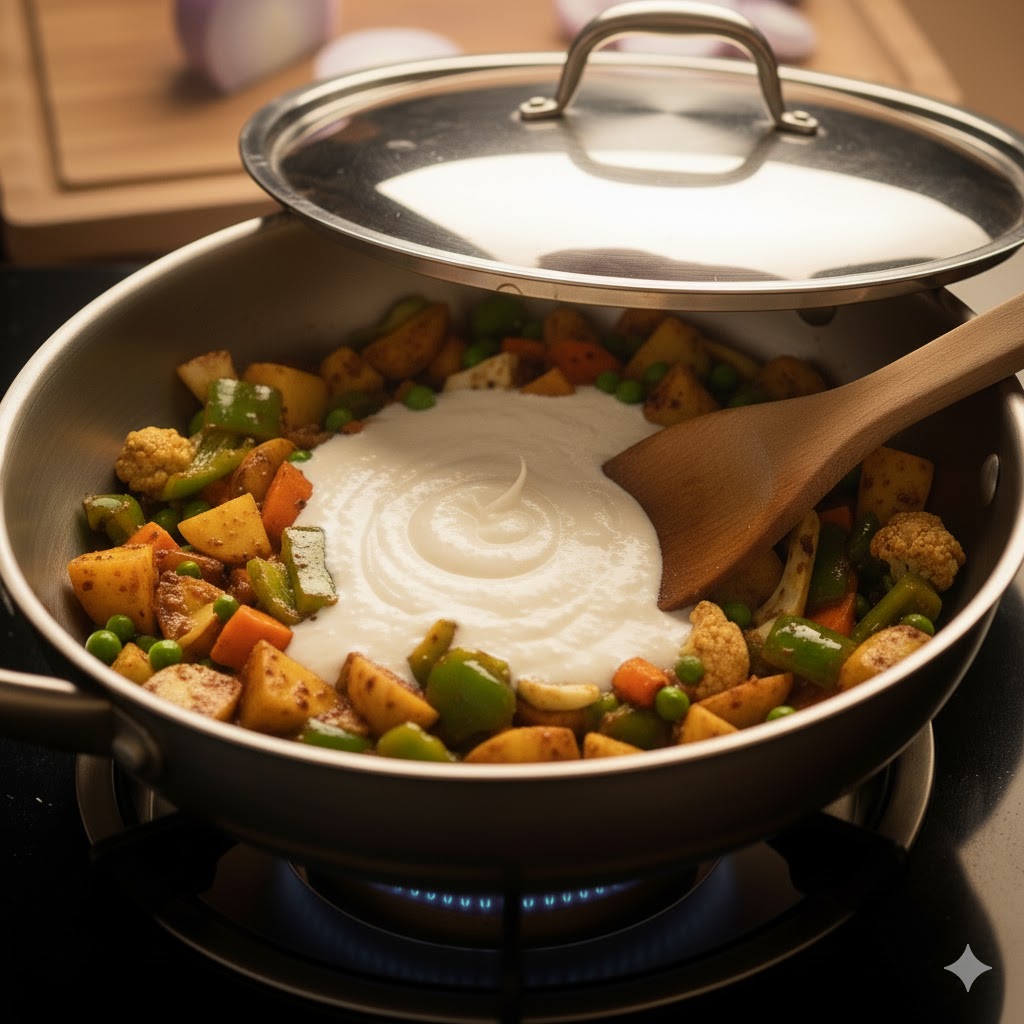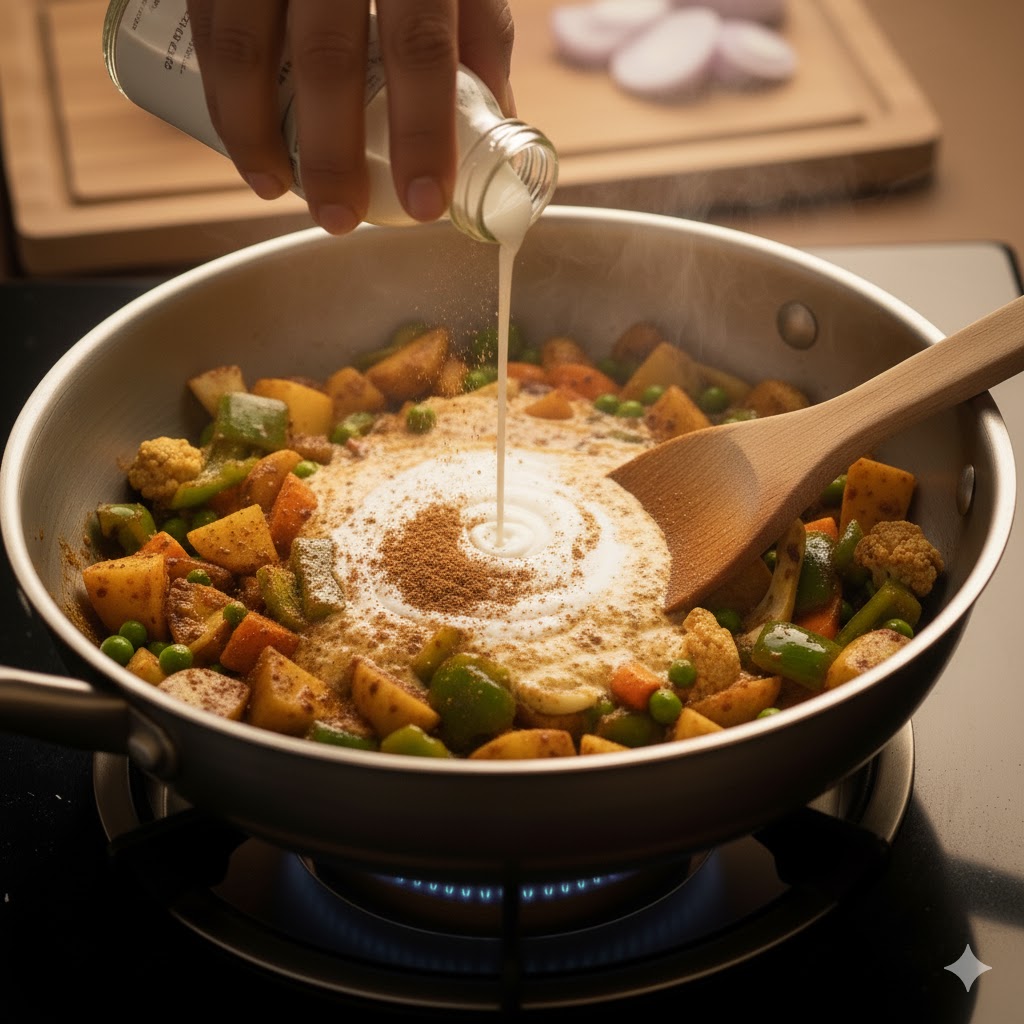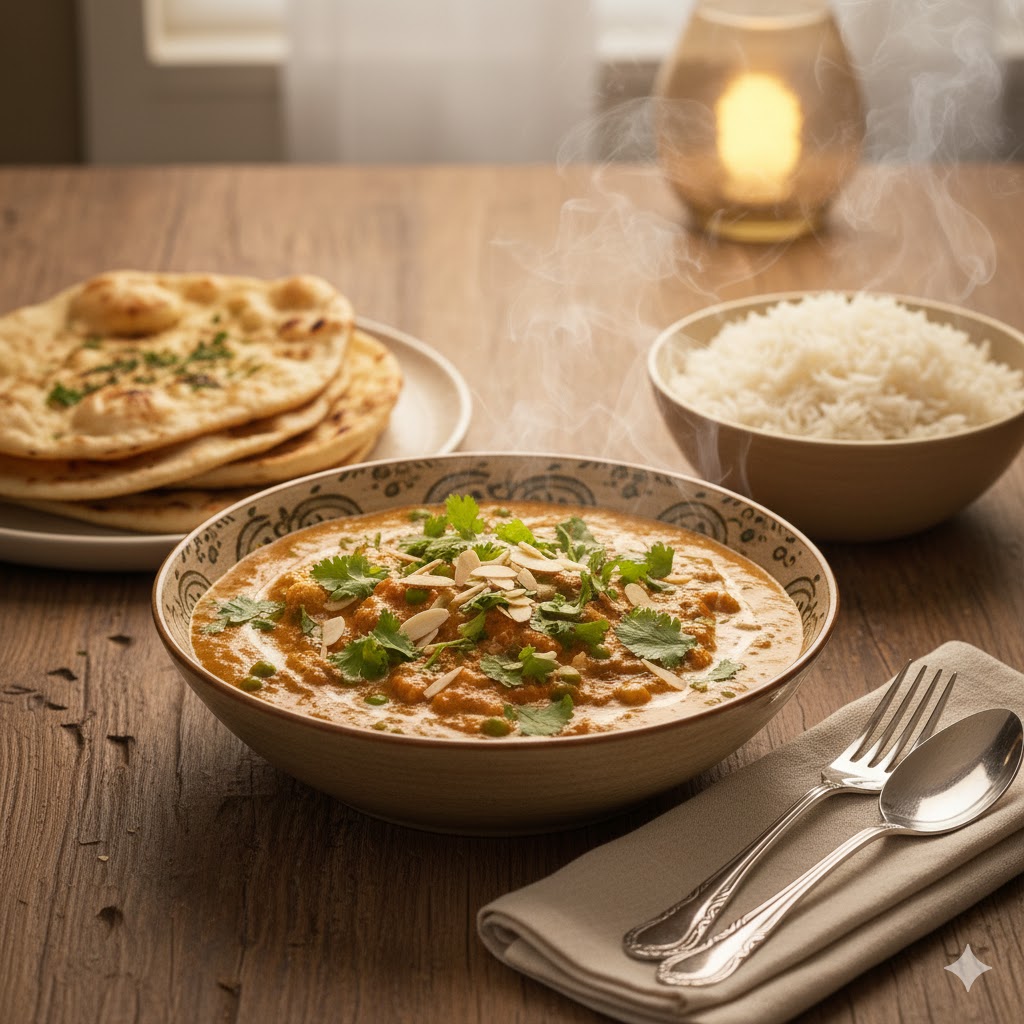
Restaurant Style Vegetable Korma with Rice Bran Oil

Ideal For
Lunch
Food Type
VegIngredients
How To Cook
A creamy, aromatic vegetable curry ideal for weeknights or festive meals
If you’re looking for a curry that tastes delicious but is not too complicated to make, vegetable korma is a perfect choice. It’s creamy, mildly spiced, and filled with colorful vegetables that make every bite comforting.
In this version, we will make the dish using rice bran oil, which has a high smoke point and a light to nutty flavor that goes perfectly with Indian spices. Plus, it’s a healthier alternative to heavier oils.
By the end of this guide, you’ll know not only how to cook restaurant-style vegetable korma at home but also a little about its fascinating history and how best to enjoy it.
History Behind Korma
India is known to the world for diversity, and it reflects in our food. The word “korma” or qorma comes from Persian, which means “to braise.” Back in the Mughal kitchens of the 16th century, chefs would slow-cook tender meat in a luxurious sauce of yogurt, nuts, and aromatic spices to make the dish. The original korma was rich with the flavours of ghee, saffron and almonds.
But when the dish traveled across regions, the cooking process and ingredients changed:
- In Hyderabad, cooks added coconut and tamarind.
- In South India, korma (often called kurma) was brightened with grated coconut, curry leaves, and mustard seeds.
- In North India, it leaned on cream, cashews, and whole spices for that indulgent restaurant taste.
Over time, the vegetables replaced meat for vegetarian households, giving us the delicious vegetable korma we know today.
Ingredients :
- Grated coconut 3/4th cup
- Cashews 5-10
- Poppy seeds 1 tsp
- Coriander seeds 1 tsp
- Cumin 1½ tsp
- Chilli powder 1 tsp
- Turmeric ½ tsp
- Garam masala ½ tsp
- Fennel seeds ½ tsp
- Water ½ cup
- Doctors’ Choice Rice Bran Oil 2 tbsp
- Bay leaf 1
- cinnamon ½ inch
- Cloves 4
- Cardamom 3 pods
- Star anise 1
- Chopped onion 1
- Ginger garlic paste 1 tsp
- Chopped tomato 2-3
- Peas ½ cup
- Chopped carrot 1/2
- Chopped beans 5
- Chopped potato 1
- Cauliflower 1 cup
- Green chilli 1
- Salt 1 tsp
- Chopped coriander leaves 2 tbsp
- Water 3 cups
1. Start with the paste.
Soak the cashews in a bowl with lukewarm water before you start copping your veggies. Once you are done with that, blend the soaked cashews with grated coconut. Add enough water to make a smooth, creamy paste. Don’t make it runny. You can try adding the water slowly. Because this is what will give your korma that restaurant-style silkiness.
2. Build the base.
Heat rice bran oil in a heavy-bottomed pan, nonstick or silver, you can use both. Toss in bay leaf, cardamom, cloves, and cinnamon. Let them sizzle for a few seconds until your kitchen starts smelling like a fine Indian restaurant.
3. Sauté onions.
Add sliced onions and sauté until golden brown. Don’t rush it, keep the gas to medium and let it cook slowly. The caramelized onions will enhance the flavour of the dish.
4. Add the spices.
Once the onions have the perfect golden hue, add ginger-garlic paste and the green chili. Stir the paste for a few minutes and then add turmeric, red chili, and coriander powder until the raw flavour of spices are gone.
5. Vegetables go in next.
Now that the masala is ready, add all the mixed vegetables and a pinch of salt. Stir well so every piece is coated with that spice base. And then cover the pan with a lid for a few minutes to let them soften slightly.
6. Pour Yogurt
When adding yogurt, lower the heat. Add whisked yogurt slowly while stirring continuously, this will keep it from curdling.
7. Add the paste
Stir the cashew-coconut paste in the pan. You can add both milk or water to make the curry thin. Then, cover with the lead again and let it simmer on low-medium heat for 5–7 minutes until the vegetables are tender but still have a bite. You can take a fork to spear the veggies to check whether it is cooked. If not, then let it simmer for a few more.
8. The finishing touch
Once everything is cooked nicely and the curry has a creamy texture, sprinkle garam masala, adjust salt, and stir once. If you want to make it more creamy, swirl in a little cream or coconut milk.
9. Garnish and serve
Finally, top with fresh coriander and slivered nuts. Serve hot with a bowl of steaming rice, paratha or naan. The aroma will pull everyone to the table before you even call them.
FAQs
Q.1. I’m cooking vegetable korma for a weeknight dinner. Can I prep anything in advance to save time?
Yes! You can chop all your vegetables, soak cashews, and even prepare the coconut-cashew paste a day earlier. Store them in airtight containers in the fridge. When it’s time to cook, you’ll just need to sauté, add spices, and simmer everything together.
Q.2. What should I do if my yogurt curdles while cooking the korma?
This usually happens if the heat is too high. Always lower the flame and whisk your yogurt well before adding. If it still curdles a bit, don’t panic, just blend the curry gently with a hand blender to bring back the creamy texture.
Q.3. How do I adjust the spice level if I’m serving kids or spice-sensitive guests?
Skip the green chili and reduce red chili powder. You can also add a spoonful of cream or coconut milk at the end to mellow down the heat without losing flavor.
Q.4. What’s the best pairing for vegetable korma, rice or bread?
Both go perfectly well. It mostly depends on what you or those you are serving like. It’s better to just ask them and prepare accordingly.
Q.5. Can I use frozen vegetables instead of fresh ones?
Yes, frozen mixed vegetables work well if you’re in a hurry. Just remember to rinse them in warm water before cooking so they don’t release too much water into the curry.
Q.6. My korma turned out too thin. How do I fix it?
Let it simmer uncovered for a few extra minutes to reduce. You can also blend a few cooked vegetables into the curry to thicken naturally, which will keep the flavors intact.
Our Hottest and Best Recipes

Total Time:
20 minutes

Kadai Mushroom, so named, is a vibrant North Indian dish that is mushrooms sautéed in spicy tomato-onion gravy and a...
Total Time:
20 minutes

If you're craving a comforting Bengali dish packed with bold flavours, Begun Shorshe (aubergines in mustard gravy) is a must-try....
Total Time:
20 minutes















